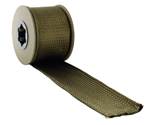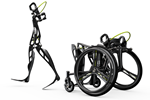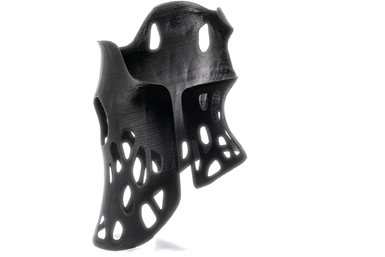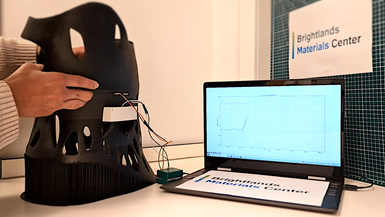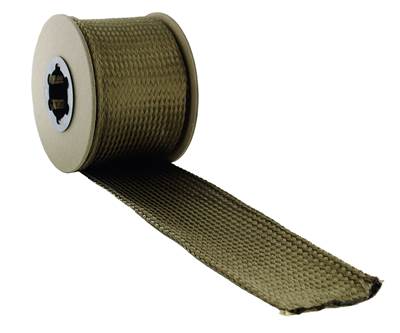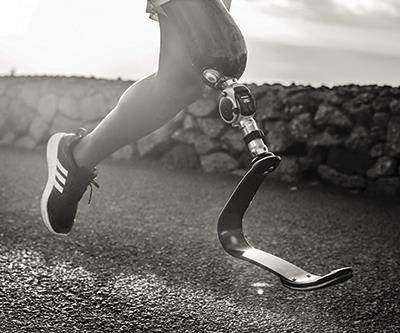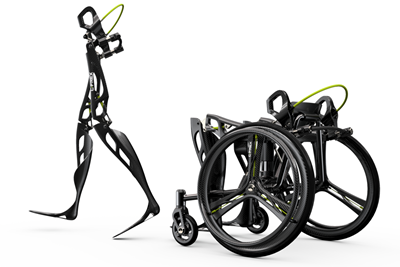Multimaterial, Self-Sensing, 3D Printed Scoliosis Braces
Startup Fited and Brightlands Materials Center have developed a lighter weight, thinner CFRP corrective brace, including pressure sensors made from continuous carbon fibers.
Corrective scoliosis braces customized to each patient. In a recent R&D project, the Brightlands Materials Center and Fited developed a 3D printed, multimaterial, sensor-enabled brace concept aiming to increase patient comfort and track how well the brace is working. Photo credit, all images: Brightlands Materials Center
Founded in 2017, startup Fited (Maastricht, Netherlands) aims to “automate the design process for patient-specific medical devices,” explains founder and CEO Erdem Ay. Before founding his own company, Ay previously worked for a company that made 3D printed shoe orthotics. He translated this experience into Fited’s first target product: 3D printed braces to correct scoliosis, a condition characterized by a sideways curvature of the spine. These braces are typically worn by adolescent patients for up to 20 hours a day for a span of several months to several years, to align the spine and prevent further progression of scoliosis until the bones have finished growing. Today’s braces are typically made from a rigid plastic, designed and molded based on scans, measurements or casts of each patient.
“Part of the reason for [choosing scoliosis braces] is that I have scoliosis in my family and my mom wore scoliosis braces when she was a child,” Ay says. “Looking at the braces that are still being sold today compared to 50 years ago, they’re more or less the same. We want to use modern manufacturing technology, automation and innovative materials to bring these braces to the contemporary era.”
Fited’s team spent the past several years working on the company’s design and manufacturing technology. To build a Fited brace, first, a suite of digital measurement techniques — including photographs, X-rays and 3D scans — is used to create 3D models of the patient and subsequent brace. The brace itself is printed on a fused deposition modeling (FDM) 3D printer, which Ay says was chosen and developed as the method that offered the best flexibility to create custom, complex geometry with the least amount of manufacturing waste. 3D printing also enables one of the most important features of the Fited braces — their abundance of designed-in holes, which make the brace more breathable and lighter weight, and therefore more comfortable for the patient leading to increased patient compliance.
The company’s first braces are made fully from polypropylene (PP), and Ay says that these will begin to launch in several European markets in the first half of 2024, followed by a U.S. launch in late 2024.
While developing and testing these initial PP braces, Ay says the Fited team recognized an opportunity to go a step further with the next iteration. “Because these patients are usually adolescents and are usually required to wear these braces for long periods of time, it’s important to understand how the device is working in real time, to make sure the brace is working effectively and that the patient is wearing it appropriately, or if there are any changes in the patient’s condition over time,” Ay says.
Fited therefore began looking into ways of integrating sensor technology into its braces, which led to conversations with Brightlands Materials Center (BMC, Geleen, Netherlands), a branch of research organization TNO (The Hague, Netherlands). BMC had already been working on self-sensing technology using continuous carbon fibers, and in late 2021, Fited and BMC began a collaborative Bright Smart Scoliosis Brace project to incorporate self-sensing carbon fiber technology into Fited’s braces. The project was made possible through the European fund for regional development in the context of REACT-EU.
“The idea of introducing sensors is that you have real-time monitoring of what’s happening on a daily basis with the user,” explains Fidel Valega, research scientist at BMC. The challenge was figuring out how to implement this. “You don’t want to put a lot of electronics on the outside, which would make it bulky, heavy and uncomfortable, so we proposed sensors we’ve designed that can be embedded within the 3D printing process. You can have a minimalistic look but also very good integration of the sensing functionality within the brace with a minimum footprint.”
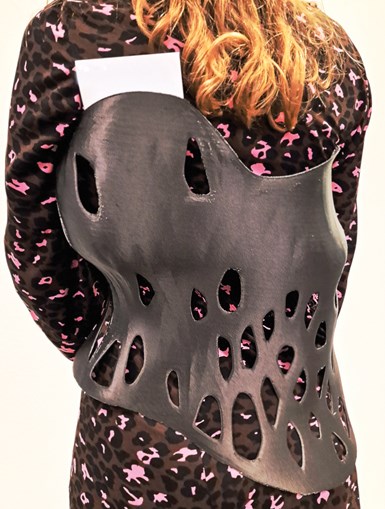
Scoliosis braces like the pictured Bright Smart Scoliosis Brace prototype are worn by patients for up to 20 hours per day.
Along with introducing this technology, the project also aimed to reevaluate materials to produce a brace that is as lightweight and comfortable for the user as possible. Using a Fited brace design, BMC evaluated and chose materials, designed a sensor system, 3D printed a full-scale prototype brace and conducted testing.
Ultimately, the prototype brace was designed to incorporate three materials: unreinforced thermoplastic elastomer (TPE); short carbon fiber-reinforced polyamide (PA); and continuous fiber-reinforced PA. Valega explains that PA was chosen over PP for its greater commercial availability in a continuous fiber-reinforced format. The materials and thickness vary along the brace, designed for short fiber reinforcement where needed for added rigidity and pressure, and continuous fiber only where the sensors are located. The brace is printed in one shot, using a custom-made APS GmbH (Höchst, Austria) FDM 3D printer with three rotating printheads.
The addition of fiber reinforcement led to a reduction in brace thickness from 6 millimeters for a fully PP brace down to 2.5-3 millimeters and a weight reduction from 700 grams down to less than 500 grams —and significantly less than the 1.5-kilogram weight of a traditional brace.
The prototype brace contains two continuous carbon fiber sensors, wired for research purposes to external electronics and a laptop. When the sensors are pressed (as pictured here), the change in pressure is recorded and monitored.
According to Valega, the brace’s piezoresistive “sensors” are specially designed, continuous carbon fibers printed directly into the brace. “The continuous fiber is the sensor. We’ve learned how to combine different continuous carbon fibers arranged and layered in a way in which we can read changes in resistance when we locally deform the fiber. It’s like a pressure point,” he says.
These self-sensing areas are designed into the most important areas of the brace that need to maintain contact with the patient to realign the spine. For the BMC project, an external micro-controller was wired to the prototype brace to collect and store sensor data. For real-world use, Fited has developed a remote monitoring device with multiple sensors integrated into the brace itself to collect and wirelessly transmit sensor data via sensor fusion for clinicians to remotely monitor treatment progress.
The R&D project ended in September 2023, resulting in a prototype that Fited is continuing to evaluate with its own teams and university partners, with the goal of moving toward clinical trials. “We’re planning to launch the carbon fiber-reinforced braces as an option in addition to our original product in the next few years,” Ay says.
Currently, Fited builds its braces at its facility, but long-term, Ay says the goal is to provide orthosis and prosthesis centers with the technology to 3D print braces on-site.
“For BMC, this project has been quite a success,” Valega says. “We’ve helped to create a very unique, quite complex orthotic device and we’ve accomplished a lot in a year and a half. We were able to bring together several technologies we had been previously working on in this project, and all the puzzle pieces came together very nicely.”
More From This Author
Hannah Mason reports about the composites manufacturing industry for CompositesWorld and about sustainability in manufacturing for parent company Gardner Business Media. SUBSCRIBE HERE
Read Next
Basalt fiber gives prosthetics more “give”
Prosthetics and orthotics often take advantage of composite materials’ strength and durability. Basalt fiber has given manufacturer Coyote Design (Boise, ID, US) a performance edge.
Read MoreCFRP: Opportunities in orthopedics
Carbon fiber has a niche, but can it secure a larger piece of a high-growth pie?
Read MoreC-FREX exoskeleton depends on CFRP for unpowered movement
C-FREX uses a novel design and CFRP to overcome the heaviness and weakness of metallic exoskeletons.
Read More
.jpg;width=70;height=70;mode=crop)
